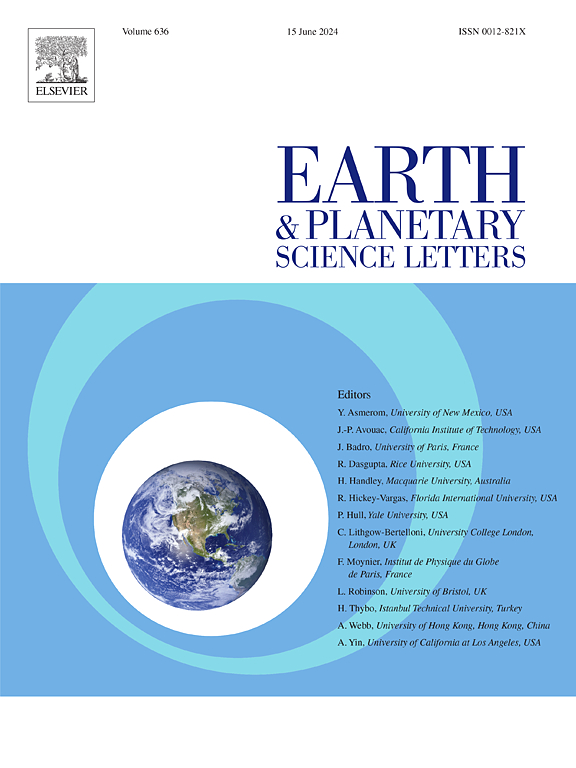Characterization of bedrock mass-wasting at fault-bound abyssal hills
IF 4.8
1区 地球科学
Q1 GEOCHEMISTRY & GEOPHYSICS
引用次数: 0
Abstract
Fault-bound abyssal hills form at mid-ocean ridges and cover ∼65 % of Earth's surface, but few studies have characterized the extent to which bedrock erosion controls their morphology. Here, we use bathymetry data to characterize the morphology of fault-bound abyssal hills on a global scale, and employ numerical modelling and seismicity catalogues to quantify how simultaneous rock uplift and bedrock erosion sculpt deep-ocean landscapes. By generating a global database on abyssal hill morphology, we show that most large abyssal-hill scarps (>100 m in height) within the near-axis zone of seismicity (i.e., <30 km from axis) have slopes between 10 and 30°, well below the expected range of underlying normal fault dips of 45–60°. We interpret this as a manifestation of efficient bedrock mass wasting on near-axis growing faults, a process that operates from fault inception. Using a non-linear topographic diffusion model to parameterise the effects of erosion, we find a balance between erosion and rock uplift that is similar for slow, intermediate, and fast spreading rates. We express the ratio of erosion to uplift as an inverse Peclet number that ranges between 0.06 and 0.82 for abyssal hills. We also calculate a global bedrock diffusivity for abyssal hills in the range 0.01–1.51 m2 yr−1. These results imply that bedrock erosion is a significant process that sculpts abyssal hill morphology and reshapes the oceanic crust. Overall, this study provides a framework to incorporate bedrock mass wasting into future models of ocean-floor evolution and, more generally, to active extensional settings on Earth and beyond.
断层深渊丘陵基岩岩体流失的特征
断层深海丘陵形成于大洋中脊,覆盖地球表面的 65%,但很少有研究描述基岩侵蚀对其形态的控制程度。在这里,我们利用水深测量数据来描述全球范围内断层深海丘陵的形态特征,并利用数值建模和地震目录来量化岩石隆起和基岩侵蚀是如何同时雕塑深海景观的。通过生成全球深海丘陵形态数据库,我们发现地震近轴区(即距轴线 30 公里处)的大多数大型深海丘陵疤痕(高 100 米)的斜率在 10 至 30° 之间,远低于底层正常断层倾角 45 至 60° 的预期范围。我们将此解释为近轴生长断层上基岩大量流失的一种表现形式,这一过程从断层一开始就在起作用。利用非线性地形扩散模型对侵蚀作用进行参数化,我们发现侵蚀和岩石隆起之间的平衡在慢速、中速和快速扩展速率下都是相似的。我们将侵蚀与隆起之比表示为一个逆佩克莱特数,对于深海丘陵而言,该数值介于 0.06 与 0.82 之间。我们还计算出深海丘陵的全球基岩扩散率在 0.01-1.51 m2 yr-1 之间。这些结果表明,基岩侵蚀是塑造深海丘陵形态和重塑大洋地壳的重要过程。总之,这项研究提供了一个框架,可将基岩大规模流失纳入未来的洋底演化模型,并更广泛地纳入地球及其他地区的活动伸展环境。
本文章由计算机程序翻译,如有差异,请以英文原文为准。
求助全文
约1分钟内获得全文
求助全文
来源期刊

Earth and Planetary Science Letters
地学-地球化学与地球物理
CiteScore
10.30
自引率
5.70%
发文量
475
审稿时长
2.8 months
期刊介绍:
Earth and Planetary Science Letters (EPSL) is a leading journal for researchers across the entire Earth and planetary sciences community. It publishes concise, exciting, high-impact articles ("Letters") of broad interest. Its focus is on physical and chemical processes, the evolution and general properties of the Earth and planets - from their deep interiors to their atmospheres. EPSL also includes a Frontiers section, featuring invited high-profile synthesis articles by leading experts on timely topics to bring cutting-edge research to the wider community.
 求助内容:
求助内容: 应助结果提醒方式:
应助结果提醒方式:


